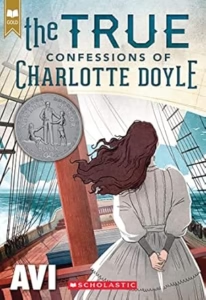The True Confessions of Charlotte Doyle
Avi
Scholastic, Inc.
Published October 27, 2015 (Orig. 1990)
Amazon | Bookshop | Goodreads
About The True Confessions of Charlotte Doyle
Thirteen-year-old Charlotte Doyle is excited to return home from her school in England to her family in Rhode Island in the summer of 1832. But when the two families she was supposed to travel with mysteriously cancel their trips, Charlotte finds herself the lone passenger on a long sea voyage with a cruel captain and a mutinous crew. Worse yet, soon after stepping aboard the ship, she becomes enmeshed in a conflict between them!
What begins as an eagerly anticipated ocean crossing turns into a harrowing journey, where Charlotte gains a villainous enemy . . . and is put on trial for murder!
After Words material includes an author Q&A, journal writing tips, and other activities that bring Charlotte’s world to life!
My Review
I first read this book in elementary school, and I decided to revisit it as part of the reading challenges I’ve committed to for this year. One of the challenges is to revisit a childhood favorite. I chose The True Confessions of Charlotte Doyle in part because I remember loving it. I also wanted to revisit the work and think about the explorations of classism and sexism.
Twelve-year-old Charlotte embarks on a journey from England to the United States in 1832. Her family’s original plan is that two other families would accompany her on the voyage, but instead, she is the only passenger on a ship crewed entirely by men.
At first, the only person on the ship she feels comfortable with is Captain Jaggery, whom she takes to be a gentleman from the way he addresses her and his dress and such. She hears rumors from the crew and others that he is a violent man who can’t be trusted, and at first, she assumes these statements are exaggerated or just the kinds of complaints one might have if one works for a captain with high standards.
Then, she witnesses some of his cruelty. She listens to him malign the crew as if they are inferior men. At first, she doesn’t push back on his behavior. As the captain’s cruelty escalates, she begins to wonder if the crew members have been telling her the truth. She also gets to know several crew members and unpacks some of the classist statements the captain made. When she experiences prejudice herself, she further examines these ideas.
I had forgotten how tightly paced this book is. The tension builds, culminating in a murder mystery with Charlotte at its center.
The vocabulary in the book will be challenging for younger readers, but the concepts in the story largely stand the test of time. Charlotte and the crew’s lone Black man become unlikely friends. She learns a lot from him, and ultimately, she faces pivotal moments where she will have to believe him and support him in return or look out for her own interests.
Readers who enjoy a tightly paced murder mystery on the high seas or a historical novel about girls challenging gender norms and finding adventure will enjoy this one.
Content Notes
Recommended for Ages 10 to 14.
Profanity/Crude Language Content
Mild profanity used very briefly.
Romance/Sexual Content
None.
Spiritual Content
Charlotte reads Bible passages to the crew on Sundays. They pray over a crewmate who has passed away.
Violent Content
Situations of peril. One scene shows someone whipping a bound man. A man shoots another man in the chest. He dies soon after, and someone heaves his body overboard on the captain’s orders. References to a man who was beaten so badly that he lost his arm.
Drug Content
Mentions of alcohol on board and sailors drinking rum. (Drinking happens off-scene.)
Note: This post contains affiliate links, which do not cost you anything to use but help support this blog. All opinions are my own.
